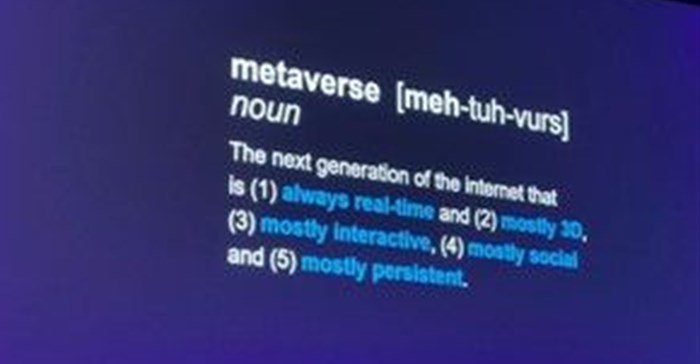Press 5 for the metaverse

As an AR strategist for the last eight years, these are my top key insights from the thought leaders driving the XR industry.
Defining the metaverse
A full year later, after all the headlines and buzz around the metaverse, people still don’t know what the metaverse means.
John Riccitello, CEO of Unity, probably gave the best definition I’ve heard.
Simply put - the metaverse is the next generation of the internet that is:
- Always real time
- Mostly 3D
- Mostly interactive
- Mostly social
- Mostly persistent
Step by step more websites will increase their adoption of 3D content and interactive and social features.
The internet has progressed from initially using text and photos and now using video content - so what is next? The future will be where the media content will come “alive”.
He goes on to say that he sees several metaverse destinations and that big brands won’t open up in the same metaverse “destination”. Rather, he sees several metaverses, each linked to each other for us to jump between. Much like we jump today between websites.
He described that we will all have avatars, but don’t see us having the same avatar for every metaverse - we’ll have (and want) the freedom to express ourselves as uniquely different across these metaverse destinations.
The metaverse will also not be exclusively accessed via Extended Reality (XR) heads set alone. Much like we have hardware preferences to access the internet today, the same will apply for accessing the Metaverse - using a combination of AR, VR, mobile or tablets. He predicts that by 2030 everyone with a website will have a Metaverse destination.
The spatial customer journey
The role of 3D content in the customer journey will become increasingly more important. Being able to visualise virtual products has the potential to boost consumer confidence and sales with more informed purchase decisions.
But this also poses a unique set of challenges for brands to create 3D content that’s scalable and affordable.
Daniel Frith, vice president of 3D, from Avataar spoke about the advancements in Neural Radiance Field technology (NeRF) and how this is already democratising 3D, introducing scale and disrupting the 3D industry.NeRF technology is able to construct 3D products at scale using AI & ML, thereby making it less time-consuming, and can cater for a large product library whilst being cost-efficient.
Revolutionise e-commerce with real-time 3D
Unity (the 3D games engine) and Salesforce announced their partnership with Commerce Cloud. Natalija Pavic, senior product manager, Global Commerce Cloud at salesforce.com, and Randal Cumming, senior business strategy manager at Unity Technologies explain that their e-commerce vision is that 80% of the top 1,000 brands will provide shopping experiences powered by real-time 3D.
Brands are now able to create interactive, personalised, and consistent brand experiences, essentially enabling meta-commerce experiences.
As the line is fading between physical & digital commerce, Brands can immerse consumers and bring context back into the purchasing decision by using AR, VR and XR.
How can brands adopt meta-commerce?
The Unity + Salesforce integration now offers the ability to check out not in a traditional way, but rather facilitate commerce at any point during the experience. In this way, storytelling is becoming super important, the ability to guide the customer through the story of the product. And for brands already using Salesforce, this product release allows marketers to see the whole transaction from experience to salesforce and enables targeted marketing campaigns. Brands are now enabled to put 3D in the hands of many via their websites & AR.
The metaverse dawns a new chapter in brand strategy
Cynthia Maller, head of CGI at Walmart and Justin Breton, brand experiences & strategic partnerships at Walmart discussed essential questions for metaverse-ready brand guidelines.
- Does your brand need a new logo for the metaverse?
- Would you use a burner brand to test prototypes and hypotheses and learn from them?
- What will the new privacy policies be? What promise do you give your customers for the experience you want to give them in exchange for their metaverse personal data?
- How will you measure success in the metaverse? There will be new KPIs but brands must remember to still link these to their short and long-term goals.
- How will you profile customers in the metaverse? As a consumer, our real-world profile is so much easier to track and define, and will be different to our profiles in the metaverse. I can be a butterfly in one metaverse destination and a rabbit in another.
- Can you attribute to this new channel? What will the analytics tools look like?
- Realise that the user journey will need to be reimagined to a spatial user journey.
- What will the impact be on customer care? Will you ask the consumer to press 5 for the metaverse? Brands will need to develop metaverse customer care.
- Is the metaverse a new channel? If so, you will need a metaverse channel manager, creative teams and media teams. You’ll also need to relook at your channel budget allocations and use a learning agenda to assess success metrics.
About Johan Walters
- Local brands ignoring the obvious while chasing shiny, new tech - 16 Oct 2023
- #BizTrends2023: A growth in digital maturity helps local brands prepare for the year ahead - 31 Jan 2023
- #AWE22: Press 5 for the metaverse - 17 Jun 2022
- #BizTrends2022: Digital transformation is dead! What's next? - 7 Jan 2022
- How data can help CMOs reach Google's elusive multi-moment - 4 Oct 2019
View my profile and articles...

